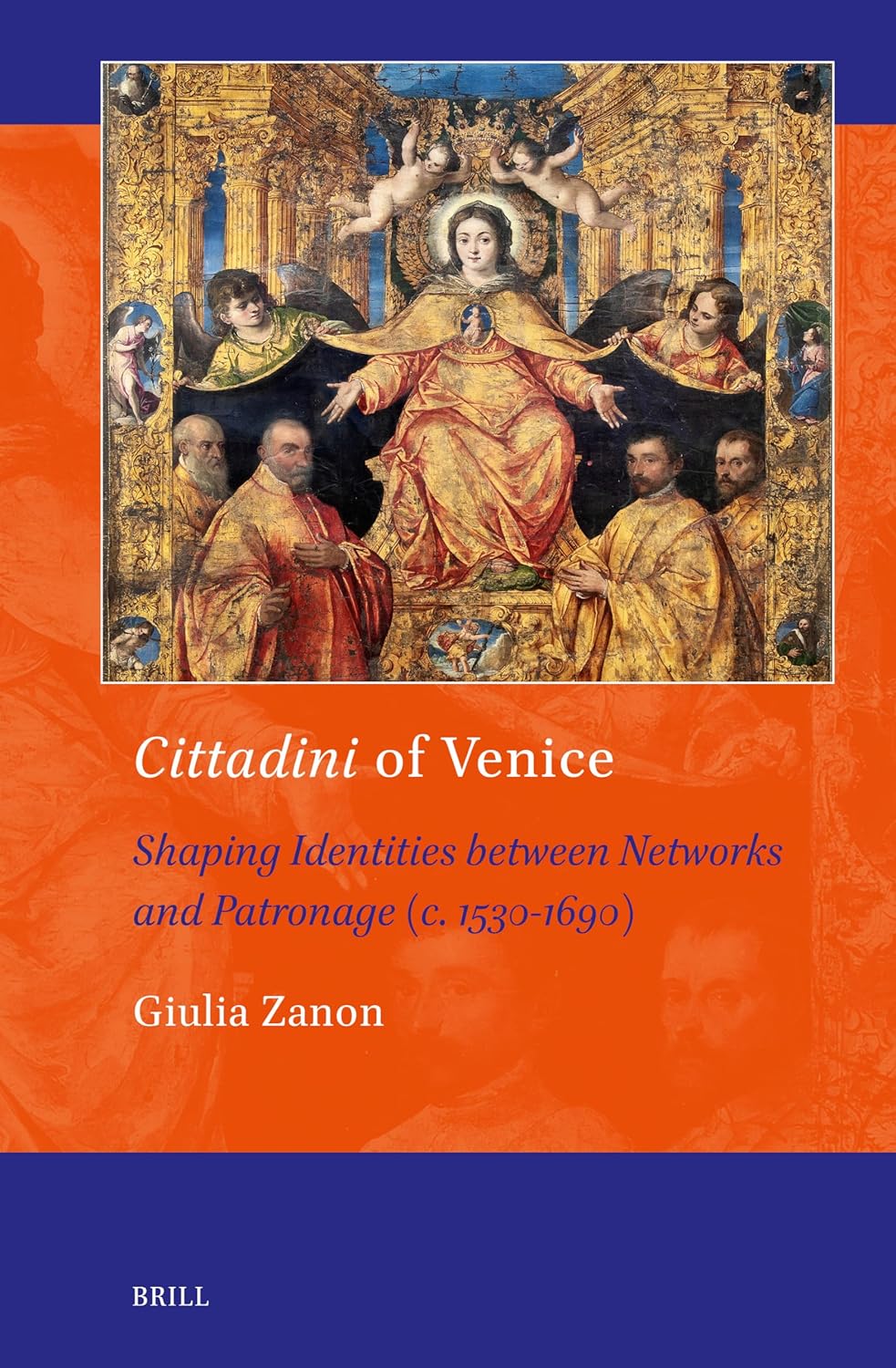


Reviewer Zoe Farrell - University of Oxford
CitationGiulia Zanon’s Cittadini of Venice. Shaping Identities between Networks and Patronage (c. 1530-1690), based on research from her PhD at the University of Leeds, explores the role of the large and heterogeneous section of Venetian society under the banner of cittadini during the later years of the Renaissance and the Counter-Reformation. In the introduction, Zanon sets out several key research goals, central to which are questions about identity, including how cittadini were legally defined and how social practices confirmed or denied membership in this elusive grouping. Importantly, she also examines the role of social relationships and patronage in shaping cittadini identity and the «conscious social elevation strategies» utilized by this group (p. 166).
She argues that cittadini identity was multifaceted and at times ambiguous, shaped not only legally (by the second half of the sixteenth century) but also through the melding of social, cultural, and familial networks, built in part by a wide range of artistic patronage. Cittadini status within this context could be confirmed or enhanced through specific patronage strategies linked to both communal and individual identity, primarily in the scuole grandi, but also within the scuole piccole and parish churches. Confraternities, in particular, became «stages» for cittadini ambition. Networks were built and strengthened within these environments as well as within humanist circles, academies, and ridotti. Through this analysis, Zanon argues that the book «provides new elements for our understanding of social hierarchy and the possibilities for social mobility in pre-modern Italy and Europe» (p. 24).
The book’s greatest strength, and what sets it apart from similar works, is the breadth of sources deployed to investigate cittadini networks and patronage. Zanon takes an interdisciplinary approach, analyzing a wide range of sources, including research into 160 folders (buste) of archival material on the scuole grandi and their interaction with the Republic. In addition to these archival sources, she skilfully and convincingly examines a range of visual and material sources. Traditional contemporary writings by authors like Sansovino and Dolce are paired with analyses of high art, architecture, medals, sonnets, gardens, inscriptions, and other cultural artefacts. The book is further illustrated with 88 images, most of which are in color, serving to elucidate discussions within the text.
The book is divided into four substantive chapters, each addressing a different theme related to the cittadini of Venice. The first chapter underlines the role of scuole grandi in shaping cittadini identity, providing detailed descriptions of their governance and the often desultory and ineffective oversight by the Council of Ten. Zanon focuses in particular on the Scuola Grande di Santa Maria della Misericordia and the Scuola Grande di San Giovanni Evangelista in her discussions of bonds within confraternities and marriage strategies used to enhance these relationships. She argues that connections created within Venice’s scuole were based not only on friendship but also on occupation, economics, and kinship. This chapter provides a detailed analysis of the governance of the scuole and their relationship to the state, making it particularly useful for students studying these institutions and the precise roles of cittadini within them.
The second chapter, the most impressive in the book (though somewhat long at 89 pages), provides a rich analysis of the diverse avenues for patronage that cittadini pursued within the scuole grandi. This exhaustive analysis goes beyond notable paintings and sculptures to explore other mediums through which members of the cittadini could project messages about themselves and their family’s status, including books, coats of arms, and medals. Unlike existing studies that focus on patronage within single scuole, Zanon takes a comparative approach across the six scuole grandi, highlighting the variety of patronage forms used to portray both individual and collective identity. While competition existed between individuals and between different scuole grandi, patronage also functioned as a means to showcase cohesion among cittadini and their distinctive role in the public sphere.
The third chapter explores the cultural networks developed among cittadini in different settings. Zanon argues that education was the foundation of cittadini identity, creating a «shared cultural interest» (p. 166), with the legal profession serving as a crucial avenue for social elevation. Beyond this, she examines the role of academies and ridotti gatherings, particularly in palaces and villas designed for such occasions. Here, she deploys a diverse range of sources, including sonnets, gardens, and family chapels. She also provides a detailed discussion of the art and architecture of Palazzo Trevisan in relation to humanist education and aspirations, arguing that cittadini lawyers used innovative forms of patronage to extend and enhance their social networks.
The fourth and final chapter explores the role of cittadini within parishes and the changes to patronage patterns brought about by the Counter-Reformation. Focusing on the reconstruction of the parish church of San Trovaso in the late sixteenth century, Zanon outlines the different ways in which cittadini responded to Tridentine precepts, depending on their existing status. By extending her analysis from the sixteenth century into the seventeenth, Zanon argues that «Counter-Reformation piety acted as a social ladder for wealthy cittadini» (p. 247). She illustrates how cittadini engaged with their parish churches and used patronage of chapels, tomb slabs, and inscriptions to demonstrate piety and status in ways that adhered to new Counter-Reformation strategies.
Zanon’s work builds on existing studies of Venetian cittadini culture and the extensive literature on scuole grandi. She engages with scholars such as Brian Pullan (Rich and Poor in Renaissance Venice), Dennis Romano (Patricians and Popolani), and Anna Bellavitis (Identité, Mariage, Mobilité Sociale). What differentiates her work is its broader investigation into individual and collective cittadini identity and its extended chronology, which allows for an assessment of continuity and change in confraternities and Venetian society.
Zanon also aligns her work with John Martin’s idea of the «social and conforming self» and takes inspiration from studies on network analysis, examining the multiplicity of networks that cittadini could call upon to enhance their reputation. Given the book's emphasis on identity, further engagement with interdisciplinary literature on identity formation particularly within less formal environments, such as the work of Rosa Salzberg, Fabrizio Nevola, and David Rosenthal, could have further strengthened her argument.
While the book is meticulously structured, some repetition occurs, particularly due to extensive outlining of aims and intentions in the introduction and at the beginning and end of each chapter. Additionally, Zanon at times eschews statistical evidence that could have reinforced her arguments – for instance, on pages 42-43 when challenging Pullan’s notion of a decline in scuole grandi over the seventeenth century and the number of cittadini in high-ranking professions such as law and medicine.
Nonetheless, Zanon presents a compelling case for the importance of studying cittadini social and patronage networks within the structure of early modern Venetian society. The book skilfully outlines how the «middle stratum of society» used artistic patronage to «legitimise its existence in the eyes of the patriciate and to distinguish and further elevate itself from the lower strata» (p. 6). As such, this book will be an invaluable resource for historians and students studying the cittadini of Venice and the social networks of the scuole grandi in particular.